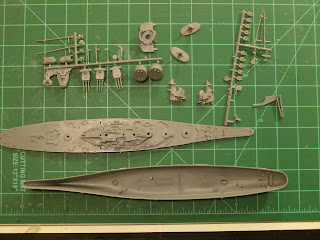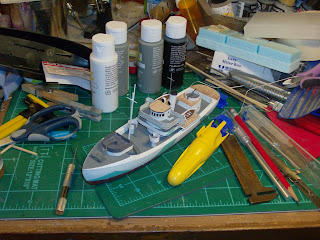Nichimo's original 30cm range of kits were very popular, so it was inevitable that there would be copies. As to whether or not they were licensed we can only speculate, however their quality varies, which leads to the possibility that at least two suspect, with one being just odd. The stated scale, where available, will be followed by the actual scale in parenthesis.
Academy's Bismarck (and Tirpitz) - 1/800 (1/836.67)
Academy's Bismarck (and Tirpitz) - 1/800 (1/836.67)
This kit began appearing in 1988, so it is safe to guess that the model dates from that period if not a little earlier.
The kit is a very good match to the Nichimo kit, with the hull components being interchangeable.
The rest of the kit looks like a match as well, though the layout on the sprue differs from the Nichimo model. The parts are crisply moulded, in some ways better than the original.
Zhengdefu (also Kitech) USS Missouri - (1/900)
Zhengdefu produced a small series of "30cm" kits, with a number of originals. Not only is this not one of their originals, it is not listed as a 30cm range kit. They are copies of the Nichimo Iowas, but not quite exact.
First, the hulls are close, but the engine and battery mount are moulded directly into the lower hull.
There are other differences, such as the parts having a "softer" appearance. The mast is also different, leaving one to suspect this model was supposed to represent an Iowa in World War II appearance. However, there are no catapults. This model was also sold as the New Jersey.
Also, the box art is interesting, as it is a flipped version of the original Nichimo artwork, with added USAAF P-47D aircraft. Creative for sure, though probably not realistic.
It should be noted that Zhengdefu appears to have also copied the Nichimo Bismarck and Enterprise.
Yong He (?) "Hyuga" - Read On
Also, the box art is interesting, as it is a flipped version of the original Nichimo artwork, with added USAAF P-47D aircraft. Creative for sure, though probably not realistic.
It should be noted that Zhengdefu appears to have also copied the Nichimo Bismarck and Enterprise.
Yong He (?) "Hyuga" - Read On
This kit is a conundrum. The box art is a copy of the original Nichimo 30cm Hyuga, meaning the model should be 1/720 scale. It is even numbered the same as the Nichimo kit.
Trouble is, this isn't the Hyuga. In fact, it isn't even an Ise at all.
The enclosed model is apparently a Kongo, and the same scale as the Nichimo kit, 1/732.
It is not, however, a copy of the Nichimo kit. It appears to be a poor copy inspired by the Nichimo Kongo. The moulding is not great, the detail is more like early plastic kits. While this model is motorized, there were serious shortcuts, one being a plastic drive shaft (in my opinion that is just asking for trouble).
This isn't a case of the the plastic components being placed into the wrong box. The instructions show that this is what it was meant to be.
This isn't a case of the the plastic components being placed into the wrong box. The instructions show that this is what it was meant to be.
In short, not the Hyuga. I know of only one more of Yong He 30cm range kit, but I would be hesitant to buy it, even for an oddity.
In the next part, we'll look at some slightly less common kits that by virtue of their size fall within this range. For now, I am going to take a break from writing and actually work on a model or two.
I shan't be gone long.
In the next part, we'll look at some slightly less common kits that by virtue of their size fall within this range. For now, I am going to take a break from writing and actually work on a model or two.
I shan't be gone long.
















































